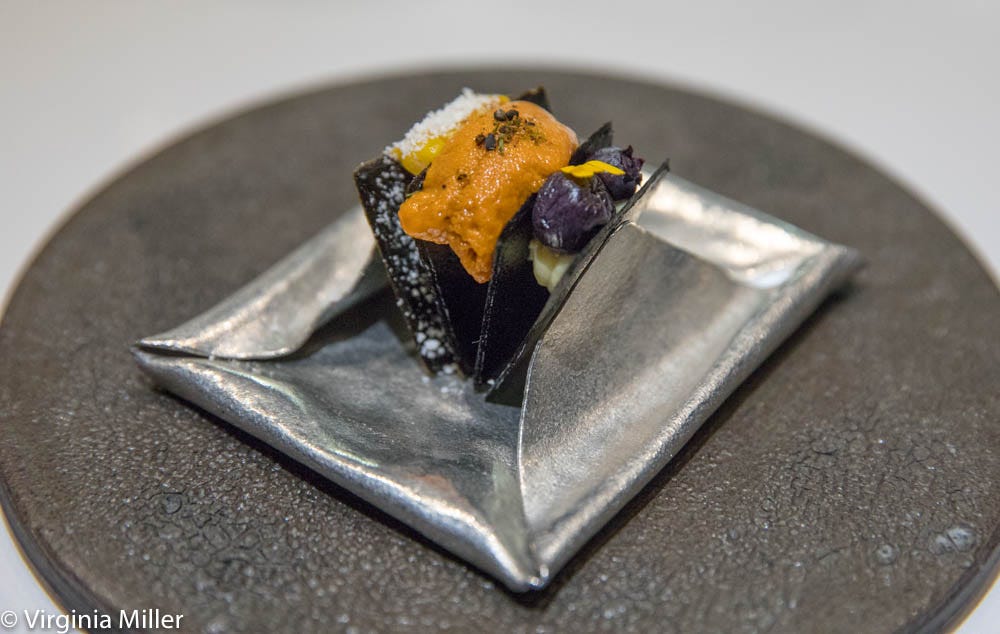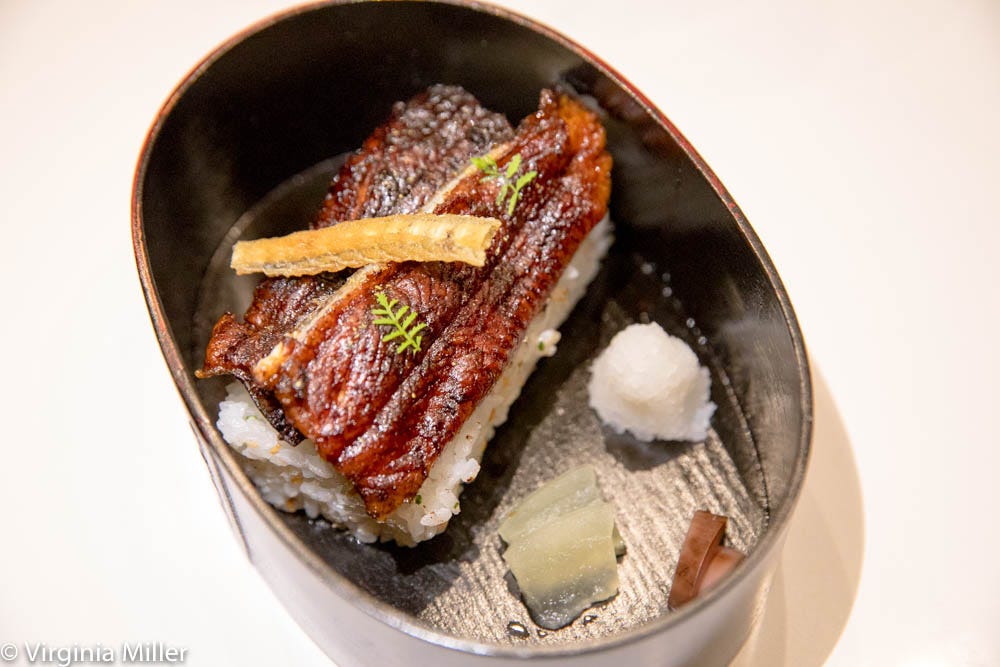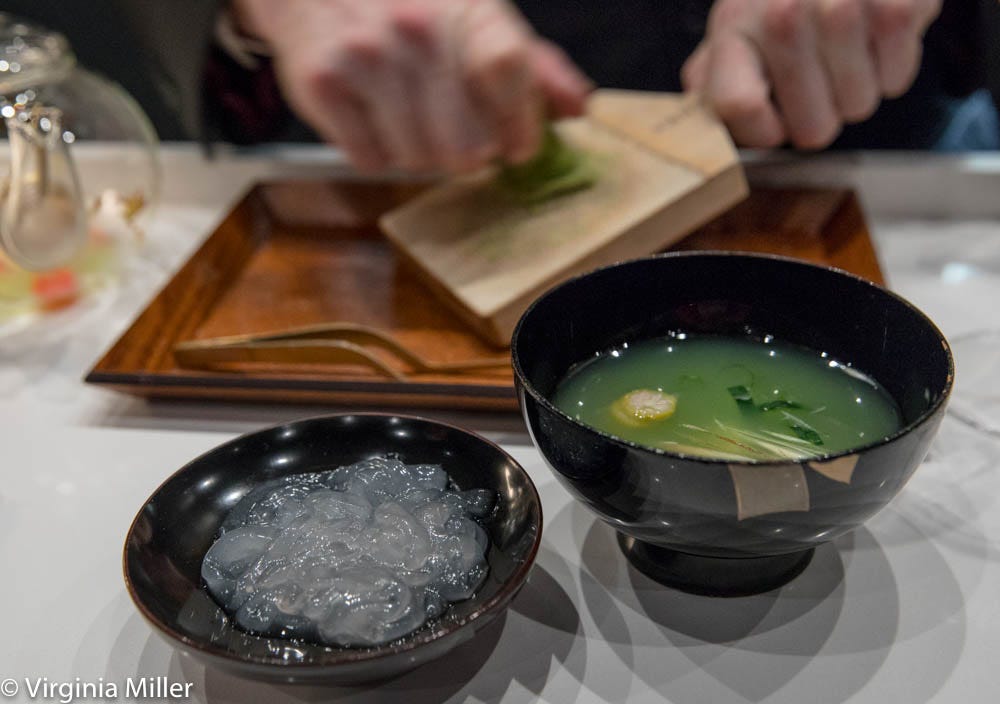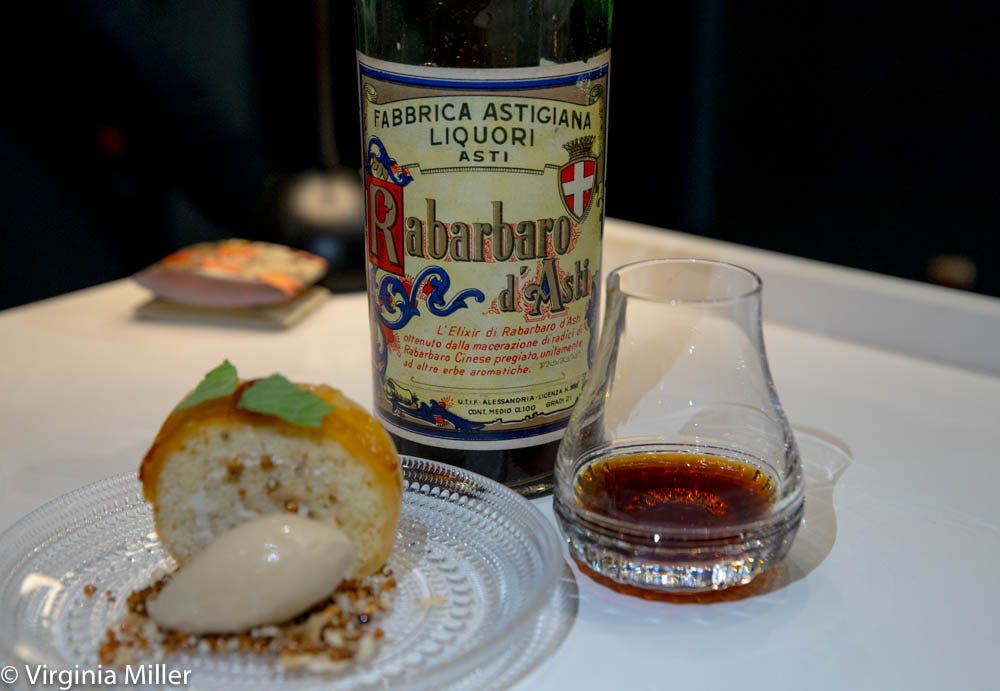From a Santa Barbera uni croquette dotted with smoked pepper relish to pumpkin chawanmushi under shaved truffles, I tasted the immediate promise dining at chef David Yoshimura’s Nisei not long after it opened in August 2021. But it was an amuse bouche of dorayaki (a mini-pancake “sandwich,” traditionally filled with sweet adzuki bean paste) layered with banana and topped with Tsar Nicoulai caviar that I was still thinking of a year later. It’s prime example of Yoshimura’s approach: daring yet refined. Thankfully, that glorious bite — which is my dream dessert — is now a caviar service platter.
On a recent September return to Nisei just past its one year mark, I found a restaurant assuredly gaining its voice, as the team is also working seamlessly with humble ease and assuredness. They also now offer a wine or sake pairing ($110 per person), the wine pairing containing a couple sakes in the mix.
Yoshimura calls their style “California Washoku” (essentially meaning ‘harmony of food,’ it’s Japanese home cooking style balancing color and flavor, trending at places like NYC’s Mifune or Imari in LA, initially defined in Japan’s Meiji period of 1868–1912). Here, the term translates to California’s peerless ingredients, Japanese roots and American sensibilities, tributing Yoshimura’s heritage as a second-generation Japanese-American (he was also former chef de cuisine at two Michelin-starred Californios).

As Dan, The Renaissance Man, and I returned, we began the night (again) at Nisei’s neighboring Bar Iris, which opened October 2021, helmed by bar manager Ilya Romanov (previously of Michelin-starred Niku). Two initial cocktail favorites from last year are still here, namely the Middlechild, a gin and tonic variation elevated with snap peas and verjus blanc grape juice, and Faithful Fool, mixing beloved Calvados (French apple brandy), yuzu sake, green apple, white vermouth, sweet woodruff plant and soda water.
Bar bites like kara-age chicken in black curry or spot-on hamachi temaki in a dissolve-in-the-mouth nori wrap with green garlic and lemon make an ideal meal or snack on their own. Delicate newer drinks like Reality Check (mezcal, absinthe, cucumber, lime, egg white, matcha) or Side Hustle (shochu, finocchietto fennel liqueur, Aperol, cantaloupe, lemon, egg white, dusted in li hung mui). While I wished for more absinthe in the former and more fennel in the latter, both are nuanced and subtle, recalling bars I’ve been to around Tokyo and Kyoto, down to the Japanese glassware.
Alley Cat, a drink of currant leaf-infused gin, Japanese awamori (a Japanese rice spirit indigenous to Okinawa), carrot, safflower and Quinquina wine. The drink holds enough carrot to make it vegetal, while the dusting of li hing mui on top adds candied, sweet and sour plum playfulness. An off-menu upcoming drink of Santa Teresa Rum, lacto-fermented mangos, cashew milk, roasted honeynut squash and calamansi is a vibrant refresher delightfully bringing Southeast Asian flavors by way of fall-winter.

On the first and third Tuesday of the month through end of 2022, Bar Iris is hosting notable pop-ups (with a portion of proceeds donated to Planned Parenthood), including October 18th hosting Tsar Nicoulai Caviar (with caviar bumps!) and October 27th 7-course Yamazaki dinner, featuring the great Japanese whisky’s 2022 limited edition single malt whiskies and Beam Suntory cocktails.
Bar Iris is a worthy night on its own, but we moved on to our Nisei feast next door. Sitting at the chef’s counter bar, we had full view through the kitchen window backed by the understated dining room. We delighted in geeking out on wine and sake with a staff member who recently got her sake certification and with gracious GM/sommelier Ian Cobb.
Nisei’s initial trio of amuse bouche bites were highlights last year. This visit, our starter trio held intriguing Maine raw scallops four ways in yuzu and fennel, as well as a puffed mochi pastry filled with hamachi, dotted with kumquat kosho. Both were tied together by the clean lines of pickled Nukazuke watermelon rind, an ideal palate cleanser.

That unexpected surprise collision of flavors I’ve come to expect from chef Yoshimura appeared just after the amuse. A little trio of nori seaweed crisps — small enough to be eaten in one bite — held grilled corn, local Santa Barbara uni (sea urchin), shichimi/tōgarashi spice mix, then took a turn with fermented blueberries. Corn and blueberry has made many a happy dessert. But with sea urchin? As with David’s banana and caviar goodness, sea urchin’s briny unctuousness sang with sweet corn and blueberries, amped up with shichimi spice.
We opted for one of each on the sake and wine pairings so we could compare and contrast (always). Choikaisan “Mount Chokai” Junmai Daiginjo Nama sake from Akita, Japan, made a round, silky pairing with the nori wraps, bringing the unpasteurized sake’s berry, white pepper, mineral notes. 2018 Willi Schaefer Riesling Graacher Domprobst Spatlese from Mosel, Germany, contrasted with slate, pear sweetness and acidity.
The next course of hiyashi-jiru (cold miso soup) with kuzu (starch of the arrowroot) noodles is one I’d long for when sick. Okra and scallion fermented in green broth is soothing like tea with vegetal layers. The almost gelatinous yet light noodles are cold dipped via chopsticks in the broth, completely different from but in the spirit of cold soba or tsukemen noodles. In addition to the glories of fresh shaved wasabi from Japan, I’ve long savored our local Half Moon Bay-grown wasabi root at many a sushi restaurant. At Nisei this visit, I learned of Mt. Shasta wasabi, also grown close to home, adding a piquant kick to the broth.
Lush ankimo (monkfish liver) pate on house shokupan milk bread with raspberries could have been dessert, and paired with the balanced sweet of 2019 Chateau Les Justices Sauternes on the wine side and gorgeous Kojima Sohonten “Untitled” Cedar Barrel Aged Kijoshu sake from Yamagata, it almost was… at course four of eleven.

One of the top drink pairings was with thin slices of Monterey abalone in fresh tomato kosho and broth, brightened by lime zest, dulse seaweed and extra virgin olive oil. I don’t often sample wines from Maryland, but a 2021 Old Westminster Albarino (yes, albarino from MD!) hit with acidic effervescence first (I always taste drink pairings first, before they change paired with food). Sipped with the abalone, notes of apricot and blossom started peeking out. Kawatsuru “Olive” Junmai Ginjo from Kagawai is an olive yeast sake that tastes more rounded and soft on its own, fuller and juicier with the dish — but not at all like olive.
Thankfully small given its richness, wakame seaweed wrapped around black cod and accompanied by torched misozuke butternut squash swims in creamy miso Tsar Nicolai caviar sauce, contrasted by the mineral goodness of 2018 Charly Nicolle Chablis 1er Cru Mont de Milieu (white Burgundy forever!) and banana-custardy 2021 Matsunosukasa “Ryuou” Junmai Ginjo sake from Shiga. It was one of my favorite dishes of the night.
The star of the larger courses last year was the American unagi (eel) course, baked flaky with caramelized crispy skin in an unagi tare glaze of soy sauce, sake, brown sugar and sweet mirin with crunchy eel crunchy spine like a chip. The unagi cours remains but evolved, the eel sweet and savory over Rue & Forsman rice, accented with tare sauce, furikake, chives, tsukemono (pickled veggies) and that little fried spine chip. Happiness.
While there is also a generous add-on course of A5 beef with numerous layers, we were too full to go there, ending our savory courses with crusted squab and chanterelle mushrooms swimming in Japanese black curry. A beautifully lean 2020 RAEN Royal St. Roberts Pinot Noir from Sonoma Coast brings the acid-fruit contrast, while Mana 1751 “True Vision” Junmai Ginjo Yamahai sake from Fukui brings savory, brown butter notes.

Devoto Gardens apple roll cake with Hodo soy ice cream and puffed grains is a cool entry into fall, but I reveled a bit more in the purity of the two other desserts courses: one, a pie-like slice of creamy Shared Cultures amazake (fermented rice drink) under a layer K&J Orchards flavorosa pluot jam with kinako (roasted soybean flour) ice cream. Then a trio of mignardises (including mochi-like peach dango) with stunning, fresh mini-green grapes that popped cool and bright, served on ice. Dessert pairings on the wine and sake side wowed, but vintage 1960s Rabarbaro d’Asti amari and a stunning Okukama Toyonaga distillery sherry cask aged 7-year-old shochu from the spirits cart were a rare treat, the kind of delights I savor at places like three Michelin Quince.
As the San Francisco/NorCal soul of Nisei’s Japanese spirit comes into sharper focus just over a year in, my initial sense that it was headed for Michelin kind of levels has only increased. It’s not just that they do fine dining creativity well, the beautiful drink pairings, now going deeper with the added sake collection, or that service is warm and attentive, though it’s all those things. It’s especially because Yoshimura’s California Japanese heritage is expressed in unique and increasingly honed form: bold yet technically astute, tasting unlike any other menu around.
// 2310 Polk Street, https://restaurantnisei.com







